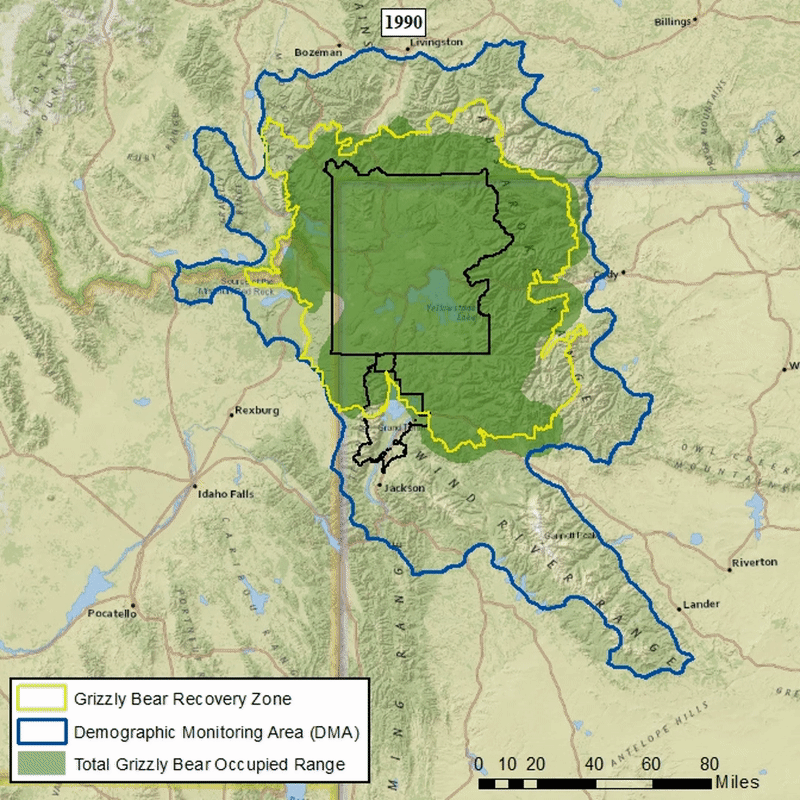In a news release on Aug. 27, 2025 officials detail a new phase of ongoing research efforts that include luring and capturing grizzly bears. Officials warn that “all areas where work is being conducted will have major access points marked with warning signs. It is critical that all members of the public heed these signs.” The research initiative is not new, but with bear captures scheduled to start Sept. 1 and last through Oct. 15, the time has come to tread carefully.
The effort is being led by the Interagency Grizzly Bear Study Team (IGBST). Per the news release officials confirm that “As part of ongoing monitoring efforts to document recovery of grizzly bears in the Greater Yellowstone Ecosystem under the Endangered Species Act, the U.S. Geological Survey, in conjunction with Yellowstone National Park, is working to inform the public that pre-baiting and scientific capture operations are once again about to begin within Yellowstone National Park.”
While visitors can still enjoy the park to its fullest the IGBST warns, “Whenever bear capture activities are being conducted for scientific purposes, the area around the site will be posted with bright warning signs to inform the public of the activities occurring. These signs are posted along the major access points to the capture site. It is important that the public heed these signs and do not venture into an area that has been posted.”
Included in the release is an explanation of the operation. Insight which makes it clear why they want people to heed their warnings. According to the IGBST, “To attract bears, biologists use natural food sources such as recently road-killed deer and elk. Potential capture sites are baited with these natural foods and if indications are that grizzly bears are in the area, culvert traps or foot snares are used to capture bears.”
The reason for the warning is the heightened bear activity in targeted areas, and traps set that hikers should safely steer clear of. The bears safety is also paramount with officials noting, “Once captured, bears are handled in accordance with strict safety and animal care protocols developed by the IGBST and approved by the U.S. Geological Survey.”
The effort is described as “vital to ongoing research and management of grizzly bears in the Greater Yellowstone Ecosystem” with a provided “IGBST trapping hotline at 406-994-6675” so community members can ask questions and get clarity on current operations.
Curious about the progress the Interagency Grizzly Bear Study Team’s effect on the Greater Yellowstone Ecosystem? Check out the image below or follow the this link to see how the grizzly bear population has expanded it’s territory since 1990.

Northern Rocky Mountain Science Center, Public Domain.
What is the Interagency Grizzly Bear Study Team
The IBSST is a well versed and established organization. According to their website “The team was formed by the Department of the Interior (DOI) in 1973 as a direct result of controversy surrounding the closure of open pit garbage dumps within Yellowstone National Park during 1968-72.”
The team is comprised of an “interdisciplinary group of scientists and biologists responsible for long-term monitoring and research efforts on grizzly bears in the Greater Yellowstone Ecosystem (GYE).” This approach “ensures consistency in data collection and allows for combining limited resources to address information needs throughout the GYE.”
The group has representatives from “the U.S. Geological Survey, National Park Service, U.S. Fish and Wildlife Service, U.S. Forest Service, the Eastern Shoshone and Northern Arapaho Tribal Fish and Game Department, and the States of Idaho, Montana, and Wyoming.”
There are two main objectives highlighted on their website:
- Monitor the status and trend of the grizzly bear population in the GYE.
- Determine patterns of habitat use by bears and the relationship of land management activities to the welfare of the bear population.
The team focuses on three main areas to achieve the above goals:
- Unique Females with Cubs-of-the-Year
The effort tracks female grizzly bears with cubs which is “generally representative of the trend for [the] entire population.” Information gained from this focus “is crucial to evaluate trends in the grizzly bear population and assess the long-term health of the population.” - Radio-Collaring Bears
The operation uses radio collaring to “document age of first reproduction, average litter size, cub and yearling survival, how often a female produces a litter, and causes of mortality. [This] data allows [the IGBST] to estimate survival among different sex and age classes of bears.” Additionally, “Location information obtained from collared bears also provides reliable data that helps resource managers focus their activities toward landscape issues that impact grizzly bears in the GYE.” - Whitebark Pine Monitoring
According to the IGBST “Whitebark pine seeds are high in fats and proteins and, when available, allow grizzly bears to build up fat reserves during fall in preparation for hibernation.” The “data show[s] that mature, cone-producing whitebark pine trees in the GYE have experienced substantial mortality, primarily due to a mountain pine beetle outbreak that started in the early 2000s, but also from white pine blister rust, and fire.” The monitoring of these trees is important because grizzly bears “make extensive use of it in years of good cone production.”
